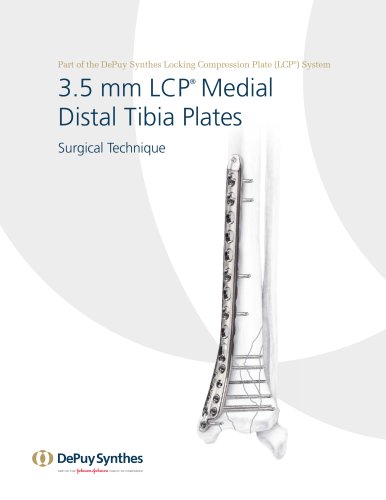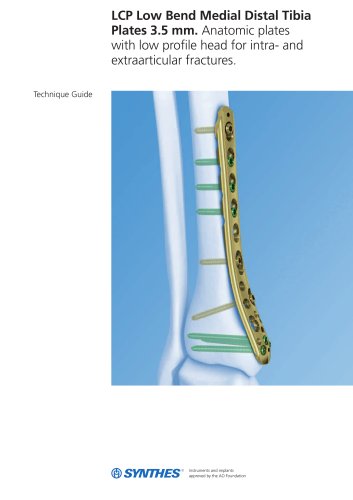 Website:
Depuy Synthes
Website:
Depuy Synthes
Group: Johnson & Johnson
Catalog excerpts

Guidance for Cementing Total Knee Replacements
Open the catalog to page 1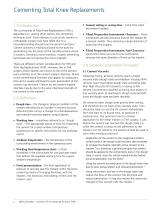
Cementing Total Knee Replacements 1.0 Introduction The survivorship of Total Knee Replacement (TKR) is dependent on, among other factors, the cementing technique used.1 Early attempts to use acrylic cement in orthopaedic surgery may have failed due to a misunderstanding around how the cement functions.2 Cement achieves a mechanical bond to the bone by penetrating into the pores of the cancellous bone where it hardens, forming a micro-interlock; modern cementing techniques aim to improve this micro-interlock. There are different cement considerations for TKR and Total Hip Replacement (THR)....
Open the catalog to page 2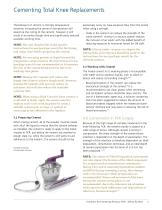
The behavior of cement is strongly temperature sensitive; increasing the cement's temperature will speed up the curing of the cement, however it will result in an earlier dough-time and significantly reduced available working time. NOTE: The user should refer to the specific instructions for use (package insert) for the timing and usage chart before preparing the cement. NOTE: Pre-warming powder or liquid beyond the temperature range stated in the instructions for use (package insert) is not recommended as it increases the risk of the cement being used too late in its working time phase....
Open the catalog to page 3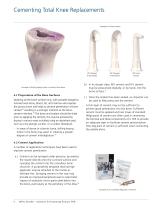
Cementing Total Knee Replacements Examples of knee nozzles 65˚ Flanged Knee Nozzle Example of drilling keying holes in sclerotic tibial bone 4.1 Preparation of the Bone Surfaces Washing all the bone surfaces (e.g. with pulsatile lavage) to remove loose bone, blood, fat, and marrow also exposes the porous bone and helps to achieve penetration of bone cement13 resulting in a stronger interlock at the bonecement interface.14 The bone and implant should be dried prior to applying the cement; this may be achieved by drying in various ways including using an absorbent pad, such as a dry sponge,...
Open the catalog to page 4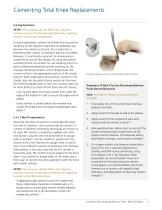
Cementing Total Knee Replacements 4.3 Implantation NOTE: The surgeon should follow the implant system’s surgical technique guidelines for applying cement to the knee components. During implantation, cement must flow from around the periphery of the implant to generate an adequate seal between the implant and bone; this is important in preventing later ingress of osteolytic particles and debris. However, it is extremely important to remove excess cement from around the implant. By using the cement according to the instructions for use (working time for a given ambient temperature) and by...
Open the catalog to page 5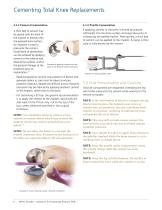
Cementing Total Knee Replacements 4.3.2 Femoral Cementation A thick bed of cement may be placed onto the back of the implant or directly onto the exposed bone surface. An impactor is used to pressurize the cement. Good levels of penetration can be achieved by applying cement to the anterior and distal bone surfaces, and to the posterior flanges of the prosthesis prior to implantation.21 If applying cement to the bone it should be pressed sufficiently into the bone surface and peg holes prior to introducing the patella implant. Alternatively, a thick bed of cement can be applied to the...
Open the catalog to page 6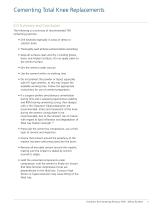
6.0 Summary and Conclusion The following is a summary of recommended TKR cementing practices: • Drill keyholes especially in areas of dense or sclerotic bone. • Thoroughly wash all bone surfaces before cementing. • Keep all surfaces clean and dry, including gloves, bone, and implant surfaces. Do not apply saline to the cement surface. • Mix the cement under vacuum. • Use the cement within its working time. • Do not preheat the powder or liquid, especially with HV type cements, as this may impact the available working time. Follow the appropriate instructions for use on cement preparation. •...
Open the catalog to page 7
Cementing Total Knee Replacements 7.0 Ordering Information SMARTSET® MV Bone Cement SMARTSET® HV Bone Cement DePuy CMW 1 Gentamicin Bone Cement SMARTSET® MV Endurance Bone Cement SMARTSET® GMV Bone Cement Cat. No. DePuy CMW 2 Gentamicin Bone Cement Cat. No. SMARTSET® GHV Bone Cement Cat. No. 8 DePuy Synthes Guidance for Cementing Primary TKR
Open the catalog to page 8
Cementing Total Knee Replacements 8.0 References 1. Philips, A. M., Tomlinson, E., Goddard, N. J. (1996). Current technologies in total knee replacement: Results of a national survey. Annals of The Royal College of Surgeons of England, 78, 515-520. 13. Majokowski, R. S., Miles, A. W., Bannister, O. C., Perkins, J., Taylor, G. J. S. (1993). Bone surface preparation in cemented joint replacement. The Journal of Bone and Joint Surgery, 75 (3): 459-463. Charnley, J. (1972). Acrylic cement in orthopaedics surgery. Churchill Livingstone, 95. Guha, A. R., Debnath, U. K, Graham, N. M. (2008)....
Open the catalog to page 9
Cementing Primary Total Knee Replacements 11 DePuy Synthes Guidance for Cementing Primar
Open the catalog to page 10
Cementing Primary Total Knee Replacements Guidance for Cementing Primary TKR DePuy Synthes
Open the catalog to page 11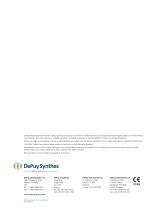
Limited Warranty and Disclaimer: DePuy Synthes products are sold with a limited warranty to the original purchaser against defects in workmanship and materials. Any other express or implied warranties, including warranties of merchantability or fitness, are hereby disclaimed. Please also refer to the package insert(s) or other labeling associated with the devices identified in this surgical technique for additional information. CAUTION: Federal Law restricts these devices to sale by or on the order of a physician. Some devices listed in this surgical technique may not have been licensed in...
Open the catalog to page 12All Depuy Synthes catalogs and technical brochures
-
ZERO-P NATURAL™PLATE
5 Pages
-
2.0 mm LCP® Distal Ulna Plate
20 Pages
-
SYNFLATE SYSTEM
3 Pages
-
2.4 mm VA LCP™
4 Pages
-
Building on Success
16 Pages
-
HEALIX ADVANCE
4 Pages
-
RADIUS OF CURVATURE
3 Pages
-
Introducing The Variable Angle
12 Pages
-
HEALIX Anchor™ 3.4 mm
2 Pages
-
Small Battery Drive II
4 Pages
-
HEALIX ADVANCE
4 Pages
-
3.5 mm LCP™ Medial
15 Pages
-
Titanium Sternal Fixation System
34 Pages
-
MatrixRIB®FixationSystem
86 Pages
-
Mandible Trauma Solutions
2 Pages
-
Power line II
4 Pages
-
Concorde
28 Pages
-
LCP Intercarpal
31 Pages
-
LCS® COMPLETE™
2 Pages
-
Synthes TPLO.
8 Pages
-
SynFix-LR System
56 Pages
-
ATB Anterior Tension Band Plate
32 Pages
-
CONDUIT™
15 Pages
-
Brochure_FINAL
2 Pages
-
DePuy Synthes
81 Pages
-
Anspach
3 Pages
-
Orthopedic Foot Instruments
32 Pages
-
PINNACLE® Hip Solutions
12 Pages
-
Corail
24 Pages
-
S-ROM® NOILES™
68 Pages
-
TRI-LOCK® Product Rationale
12 Pages
-
Reclaim Surgical Technique
44 Pages
-
Speed
2 Pages
-
attune
80 Pages
-
HAMMERLOCK® 2
2 Pages
-
DePuy Glenoid Solutions
2 Pages
-
Trauma Solutions. Elbow
4 Pages
-
Polar
4 Pages
-
Alveolar Distractor.
4 Pages
-
Piezoelectric System
4 Pages
-
Air Power Line II
6 Pages
-
LCP Clavicle Hook Plate
4 Pages
-
TruMatch Pin Guides
16 Pages
-
P F N A
8 Pages
-
SKILL, DEDICATION,
16 Pages
-
Orthopaedics. Overview
20 Pages
-
DURALOC
16 Pages
-
Marathon Cemented Cup
20 Pages
-
REEF Surgical Technique
16 Pages
-
MatrixNEURO
8 Pages
-
Anspach XMax
4 Pages
-
Anspach eMax 2 Plus
4 Pages
-
Small Electric Drive
4 Pages
-
Air Pen Drive
4 Pages
-
Colibri II
4 Pages
-
Spine
25 Pages
-
Expert Hindfoot Arthrodesis Nail
48 Pages
-
LCP Distal Fibula Plates
32 Pages
-
TomoFix
60 Pages
-
Expert Tibial Nail PROtect
16 Pages
-
Expert Tibia Nail
84 Pages
-
Sacral Bars
16 Pages
-
Pelvic C-Clamp
20 Pages
-
Low Profile Pelvic System
16 Pages
-
Proximal Femoral (Hook) Plate
24 Pages
-
LCP
24 Pages
-
PFNA
112 Pages
-
HCS 1.5, 2.4, 3.0
36 Pages
-
LCP Wrist Fusion
32 Pages
-
LCP Compact Hand
28 Pages
-
VA-LCP Elbow
48 Pages
-
Distal Radius
44 Pages
-
Olecranon
30 Pages
-
LCP Hook Plate
28 Pages
-
DHP & Olecranon
4 Pages
-
LCP S-A
4 Pages
-
Epoca
4 Pages
-
Philos
32 Pages
-
MultiLoc
68 Pages














